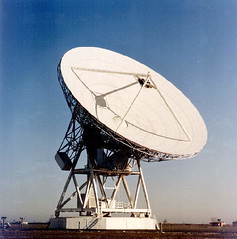SETI is predicting that it will detect ETIs within twenty years.
To achieve this, says SETI, the first 30 dishes of a huge telescope array will be operational within a year, creating a giant ear that will listen for ETIs while simultaneously gathering data for astronomy research.
This is part of what Seth Shostak is calling the "new" SETI -- an enhanced and high-tech approach to scanning to the heavens for signs of life. Some of the initiatives underway include:
- At Harvard University, a survey telescope designed to sweep massive swaths of the sky will hunt for extraterrestrial laser flashes
- In Puerto Rico, the famed Arecibo telescope is getting a new feed that will speed up searches 7-fold
- In California, the SETI Institute and Berkeley’s Radio Astronomy Lab will soon be scanning the star-clotted realms of the inner Milky Way with the first-stage implementation of the Allen Telescope Array (ATA). The ATA will eventually boast 350 antennas, each 20 feet in diameter, spread across a half square-mile of terrain; until now, SETI has used limited time from a number of radio telescopes around the world, limiting the number of stars that can be observed. However, the ATA will be dedicated to the project, speeding up the SETI search by a factor of 100.
I wish SETI all the best in their efforts, and I support all the work that they do, but I'm very skeptical that we'll hear anything in the coming decades. I don't believe that it's an issue of technical sophistication or efficiency. I simply don't believe that the signals are out there to begin with. I fall within the camp of contact pessimists who believe that the Fermi Paradox is telling us something--that life should be saturating the galaxy by now, but for some reason it isn't. That reason is hard to pin-point, and could be anything from Rare Earth to Great Filter.
If, however, we detect life in the next 20 years, then it means one of two things--one being very good and the other being very bad.
First, the bad news. If we detect a flurry of radio signals, it could mean that the Great Filter resides in our future and not our past--that it's common for intelligences to develop into post-industrial phases but no further (i.e. there's no such thing as post-Singularity intelligences). Mechanisms that are responsible include a number of possibilities, including gamma-ray bursts, advanced nanotech, resource depletion, or the further proliferation and usage of nuclear weapons.
As for the good news, it could mean that we truly live in a special time in the evolution of the Universe. This is what some cosmologists and astrobiologists refer to as the Phase Transition Model of the Universe, where the conditions for the development of advanced ETIs have only recently been established. To this point in time, it is argued, catastrophic extinction events have peppered the history of the galaxy, consequently stunting the potential advance of ETIs. The mechanism for these sterlization events would in all likelihood be gamma-ray bursts, including the high frequency of celestial impact events. Over cosmological time, it is thought, these events occur with decreasing frequency, leading to the disequilibrium of galactic sterilization and the consequent emergence of advanced ETIs (i.e. post-Singularity, post-Drexlerian nano civs, Type II and III civs, etc.).
We could very well be one of many intelligences currently developing past civilization phases never before attained in the history of the galaxy.
But like I said, we'd have to hear signals pretty soon for us to be able to add any credence to these sorts of speculations, which is why we need to support SETI in their work while remaining realistic about their chances of actually finding any signs of life out there.


No comments:
Post a Comment